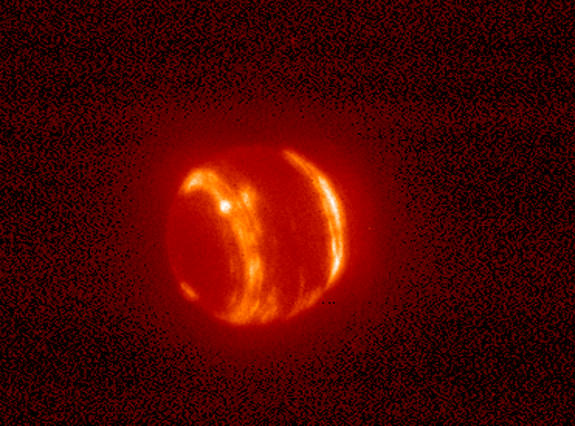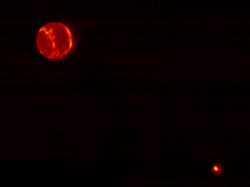The confessed (and remorseless) “Pluto Killer” astronomer Mike Brown has turned his gaze – and the 10-meter telescope at the Keck Observatory in Hawaii – on Neptune, our solar system’s furthest “official” planet. But no worries for Neptune – Mike isn’t after its planetary status… he’s taken some beautiful infrared images instead!
Normally only visible as a featureless blue speck in telescopes, Brown’s image of Neptune — along with its largest moon Triton — shows the icy gas giant in infrared light, glowing bright red and orange.
Brown’s initial intention was not just to get some pretty pictures of planets. The target of the imaging mission was Triton and learn more about the placement of its methane, nitrogen and seasonal frosts, and this sort of research requires infrared imaging. Of course, Neptune turned out to be quite photogenic itself.
“The big difference is doing the imaging in the infrared where methane absorbs most of the photons,” said Brown. “So the bright places are high clouds where the sunlight reflects off of them before it had a chance to pass through much of the atmosphere. Dark is clear atmosphere full of methane absorption.
“I just thought it was so spectacular that I should post it.”
No argument here, Mike!
Neptune, now officially the outermost planet in our solar system, is the fourth largest planet and boasts the highest wind speeds yet discovered — 1,250 mph winds scream around its frigid skies! Like the other gas giants Neptune has a system of rings, although nowhere near as extravagant as Saturn’s. It has 13 known moons, of which Triton is the largest.
With its retrograde orbit, Triton is believed to be a captured Kuiper Belt Object now in orbit around Neptune. Kuiper Belt Objects are Mike Brown’s specialty, as he is the astronomer most well-known for beginning the whole process that got Pluto demoted from the official planet list back in 2006.
Read more on Skymania.com here.
Provided by Universe Today


No hay comentarios:
Publicar un comentario